I’ll be honest. Malaysian food isn’t something I look for often, but if I had to make a list of my favorite Southeast Asian dishes, then nasi lemak would definitely be in my top ten. It’s a deliciously fragrant coconut rice dish served with sambal and a variety of side dishes like ayam goreng, fried anchovies, roasted peanuts, cucumber slices, and more.
Nasi lemak is enjoyed throughout Malaysia, where it’s considered a national dish, but it’s also common in Singapore and in other Southeast Asian countries with a sizeable Malay population. Aside from making it at home, it’s something we need to have at least once on every return trip to Malaysia and Singapore. I just love all its different flavors and textures, especially that spicy sambal!
If you prioritize local food when you travel, then Malaysian nasi lemak is a dish you need to try on your first trip to Kuala Lumpur. If you prefer exploring the world through the comfort of your own kitchen, then this nasi lemak recipe is the next best thing.
Save This on Pinterest!
No time to read this nasi lemak recipe now? Click on the save button and pin it for later!
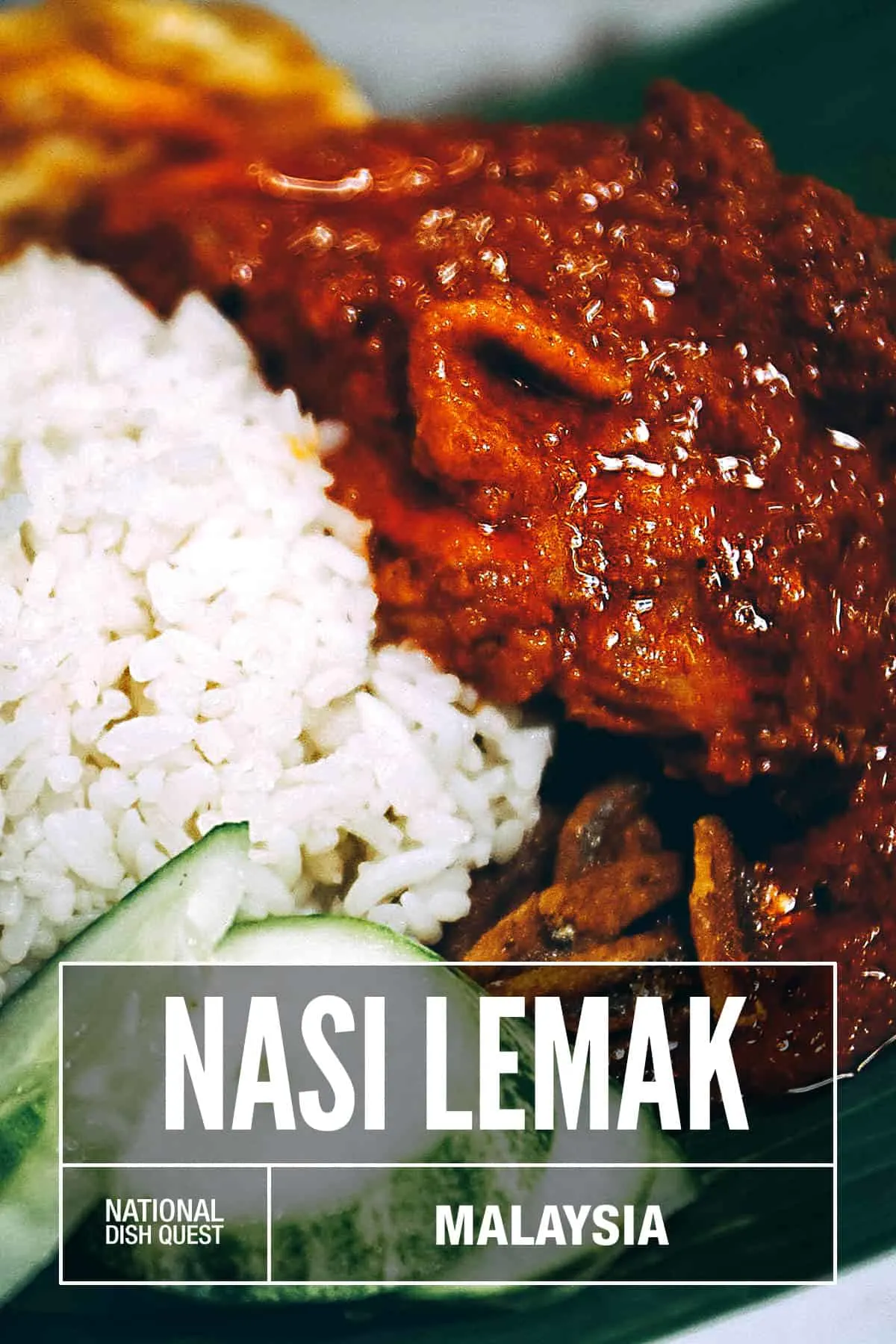
Photo by Faixal via Pixabay
WHAT IS NASI LEMAK?
If you’ve never had nasi lemak before, it’s a Malaysian breakfast dish consisting of fragrant rice cooked in coconut milk and pandan leaves. Traditionally served in a banana leaf, it’s usually eaten with sambal (chilli paste) and different viands and side dishes like chicken, sambal sotong (cuttlefish in chili), rendang, ikan bilis (fried anchovies), roasted peanuts, cucumber slices, and a hard-boiled egg.
Though traditionally a breakfast meal, nasi lemak can be eaten throughout the day, much like Filipino silog dishes. The term nasi lemak literally translates to “fatty rice” and is in reference to the richness or creaminess of the rice cooked in coconut milk. The best examples are made with freshly squeezed coconut milk (first press), but they can be made with canned coconut milk (or coconut cream, ie thick coconut milk) as well.
Pictured below is a traditional plate of Malaysian nasi lemak from a food court stall in Kuala Lumpur. It typically contains fried chicken, cucumber, roasted peanuts, fried anchovies, sambal nasi lemak, and a hard-boiled egg.
No matter what it’s served with, the true stars of nasi lemak are the coconut rice and sambal.
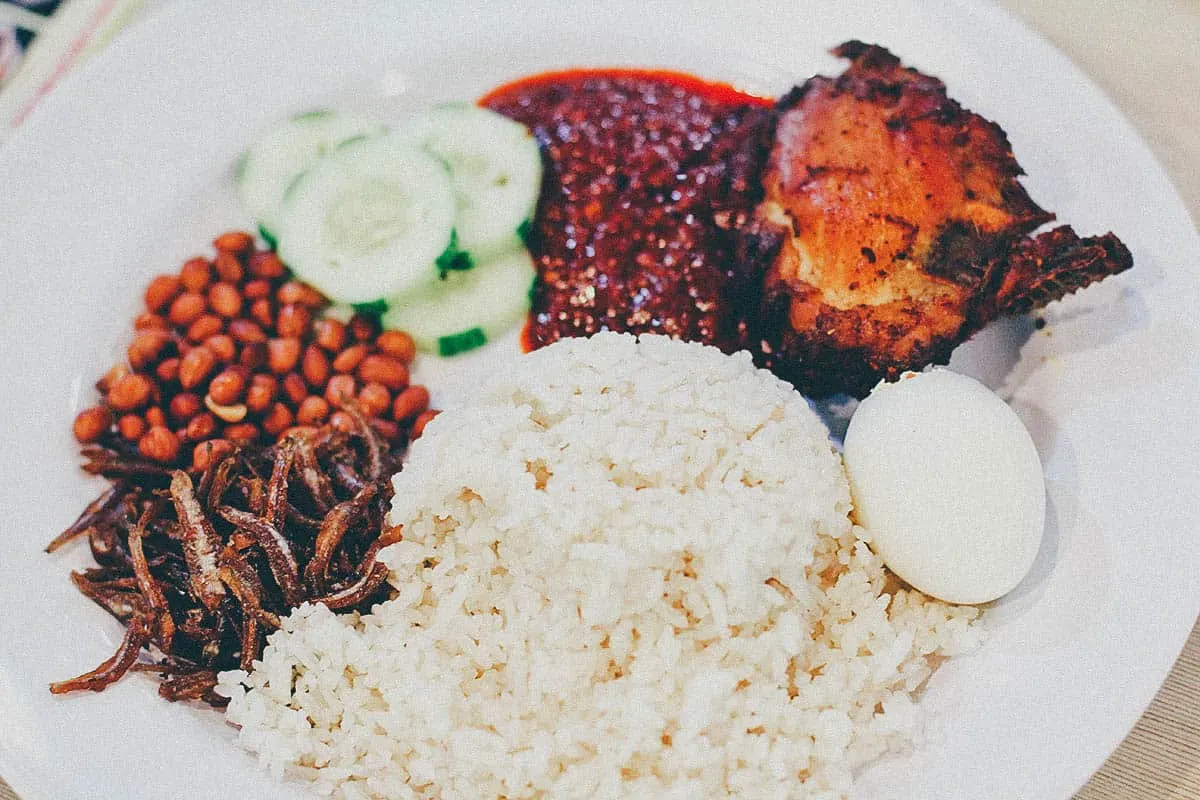
You can find nasi lemak pretty much anywhere in Malaysia – at food courts, night markets, roadside stalls, and airport restaurants. We even enjoyed it at a popular fast food chain that specialized in this beloved Malaysian national dish.
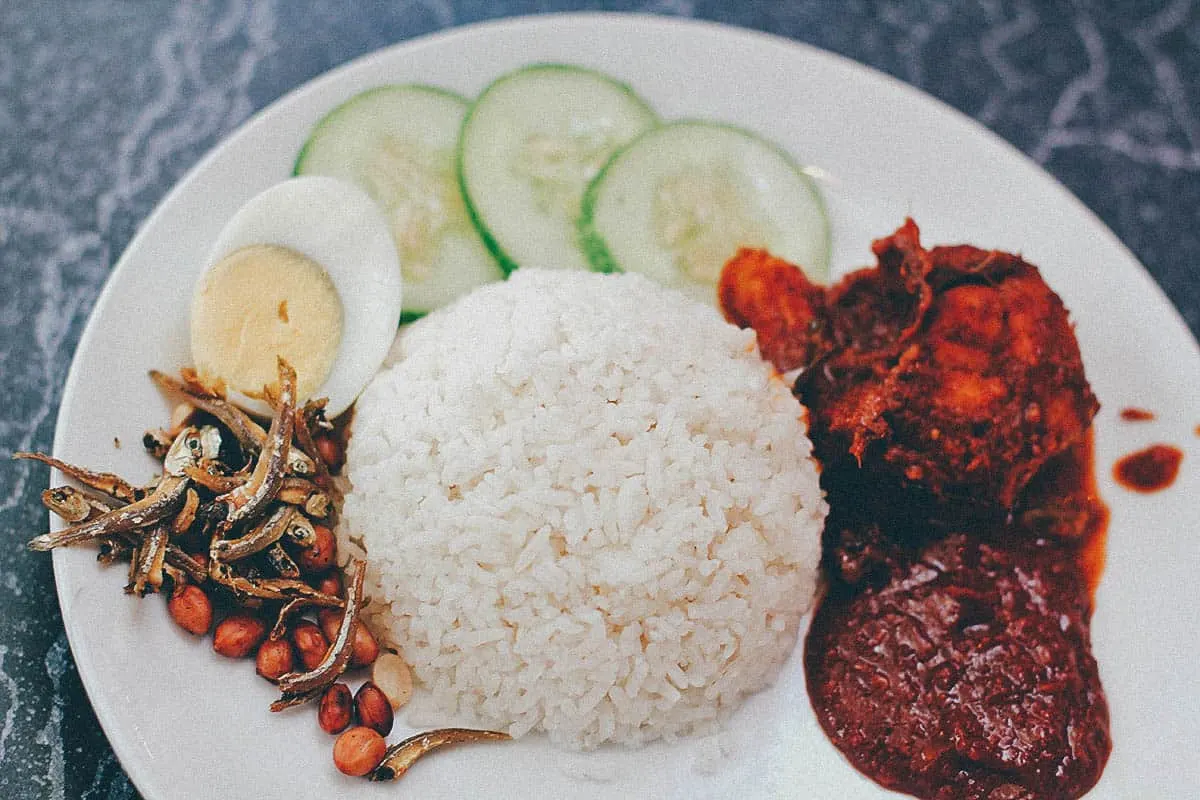
As described, nasi lemak may be Malaysia’s national dish but it’s also popular in neighboring areas such as Singapore, Indonesia, Brunei, and Southern Thailand. I’ve never seen it but it can be found in our native Philippines as well, in the Bangsamoro region of Mindanao!
Depending on where you are, you may encounter different variations of nasi lemak. There are several Malaysian variants along with a few Indonesian and Singaporean versions. They typically vary in the choice of proteins, side dishes, and types of sambal served with the coconut rice. The recipe shared in this article is for the traditional version of Malaysian nasi lemak.
The version pictured below was from a restaurant in Singapore that served them with fried chicken wings and two types of sambal – one spicy and another more sweet. Why settle for one when you can have two sambals with your nasi lemak? Delicious!
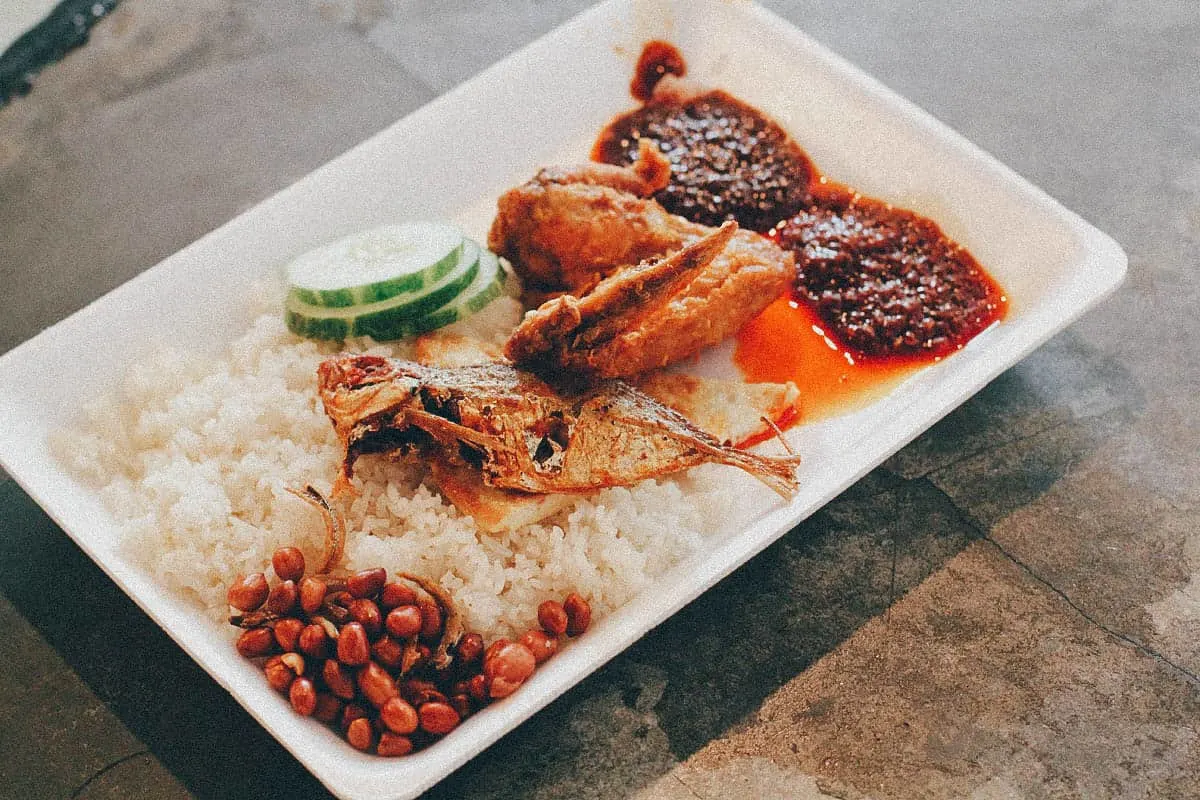
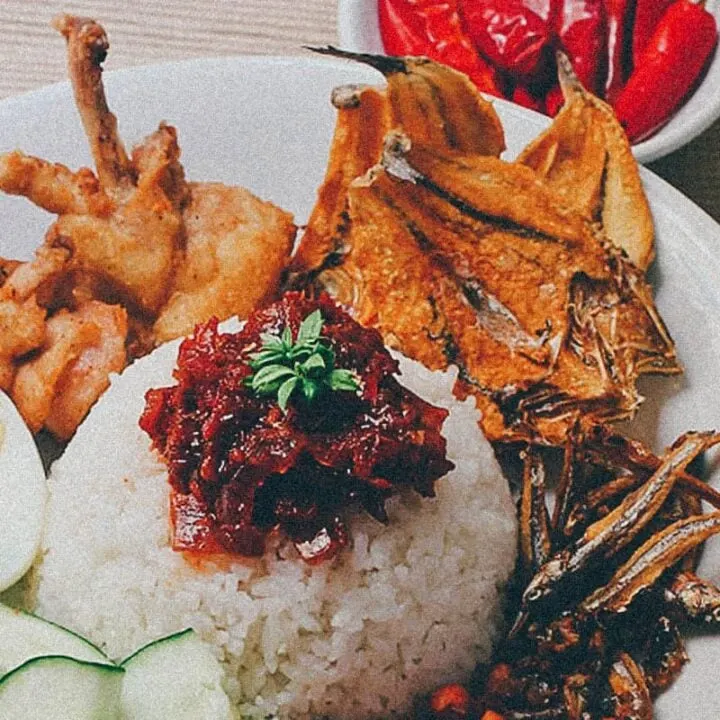
Nasi Lemak Recipe
A recipe for nasi lemak, a Malaysian national dish
Ingredients
For Coconut Rice
- 2 cups of jasmine rice
- 3 pandan (screwpine) leaves (tied into knots
- Salt to taste
- 1 small can of coconut milk (around 5.6 oz size)
- Some water
For Tamarind Juice
- 1 cup of water
- Tamarind pulp (about the size of a small ping pong ball)
For Sambal Ikan Bilis (Dried Anchovies Sambal)
- 1/2 red onion
- 1 cup of ikan bilis (dried anchovies)
- 1 clove of garlic
- 4 shallots
- 10 dried chillies
- 1 tsp of belacan (shrimp paste)
- 1/4 tsp of salt
- 1 Tbsp of sugar
Optional Ingredients
- 2 hard-boiled eggs (cut into half)
- 3 small fish (sardines or smelt fish)
- Fried chicken
- Dry, roasted peanuts
- 1 small cucumber (cut into slices and then quartered)
Instructions
- Rinse the rice and drain. Add coconut milk, a pinch of salt, and water. Add enough water so the level of the water rises up about an inch over the top of the rice. Add pandan leaves then cook in the rice cooker.
- Rinse the dried anchovies and then drain the water. Fry the anchovies until light brown. Set aside.
- Pound the prawn paste together with shallots, garlic, and deseeded dried chilies with a mortar and pestle. You can also grind them with a food processor.
- Slice the red onion into rings.
- Soak the tamarind pulp in water for 15 minutes. Squeeze the tamarind constantly to extract the flavor into the water. Drain the pulp and save the tamarind juice.
- Heat some oil in a pan and fry the spice paste until fragrant. Add in the onion rings. Add in the ikan bilis and stir well. Add tamarind juice, salt, and sugar. Simmer on low heat until the gravy thickens. Set aside.
- Clean the small fish, cut them into halves, and then season with salt before deep frying.
- Cut the cucumber into slices, and then quarter them into four small pieces.
- Plate the cooked coconut milk rice and pour some sambal ikan bilis on top of the rice. Serve with fried fish, sliced cucumber, hard-boiled eggs, fried peanuts, and fried chicken.
FINAL THOUGHTS
Here’s a mouthwatering version made by Mrs Traveleater using the nasi lemak recipe above. Doesn’t it look ridiculously delicious?
Purists may disagree, but since the most important parts of the dish are the coconut milk rice and sambal, then I think it’s ok to add whatever proteins and side dishes you want. It’s YOUR nasi lemak after all!
Instead of ayam goreng, Mrs Traveleater made this one with chicken lollipops. For more protein, she even threw in a few pieces of fried biya (dried, butterflied goby fish) from Pangasinan in the Philippines. Bon appetit!
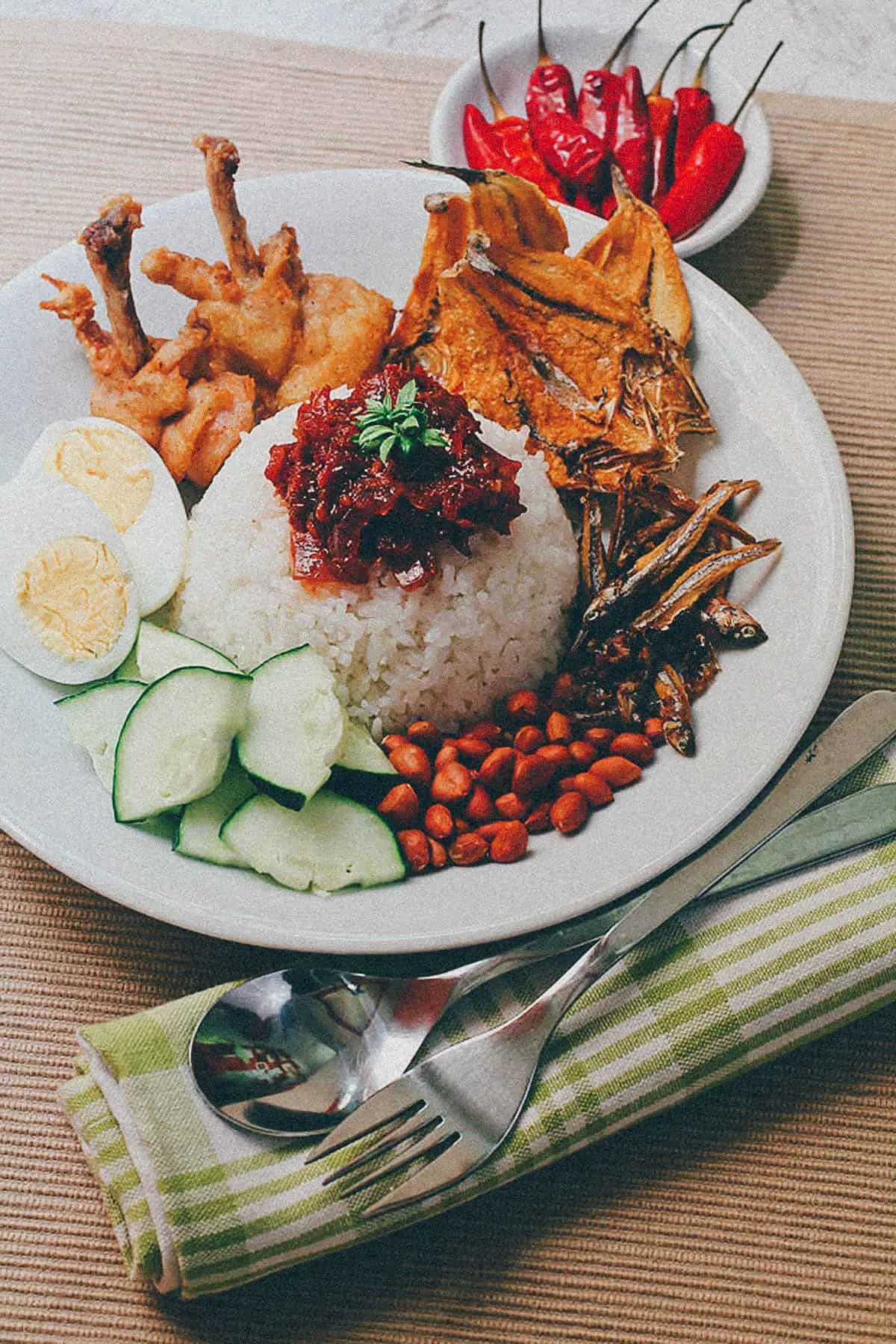
Disclosure
This recipe for nasi lemak contains affiliate links which will earn us a small commission if you make a purchase at no additional cost to you. We really appreciate your support as it helps us share more of these free recipes. Thank you!


Edwin Teo
Monday 16th of November 2020
Hi, I'm from Singapore, so I know this dish very well. I don't even have to try your recipe but I know it's a very good one. The only thing I can comment on is the actual coconut milk from a coconut but of course for convenience, canned is ok but not as good. Sometimes, I do find real frozen coconut milk from a well stocked Indian or Thai grocery store. I have not seen it at an Asian grocery store yet. But, great recipe everyone. Definitely try it.
JB & Renée
Monday 16th of November 2020
Oh wow! Thank you so much Edwin! That means a lot coming from a local. We really appreciate it! :D
And thanks for the tip about the fresh coconut milk. We'll definitely try it sometime as it's not as hard to get where we are. I'm sure it'll make a world of difference. :)
Saif
Sunday 20th of October 2019
Hi JB & Renée,
I see. I did not know they are not similar. May I ask what is the difference between sambal and sambal olek? I think I have come across in the store that sells sambal olek. Thanks
JB & Renée
Tuesday 22nd of October 2019
Hi Saif, sambal olek is basically just chili paste. The one you want is usually just labeled "sambal" or "nasi lemak sambal". It's specifically for nasi lemak. :)
Saif
Saturday 12th of October 2019
I love nasi lemak. I never went to Malaysia, but I remember the first time I tried was in a restaurant in Cebu, and I find it very delicious. Can I just used ready made sambal found in a grocery, or I should make my own? Thanks
JB & Renée
Tuesday 15th of October 2019
Hi Saif, you can use store-bought sambal, but the bottle should say just "sambal", not "sambal olek". That's something else. Hope that helps. :)
JB & Renée
Saturday 18th of March 2017
Nasi Lemak is delicious Chester. Let us know how it goes. :)
Chester Livingston
Saturday 18th of March 2017
It was good to learn something new about Malaysian food I wanted to try to eat something different. Nasi Lemak look so delicious I will try that recipe tonight. Thanks.